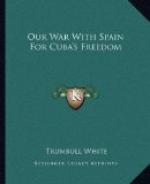The Spaniards opened fire with a four-inch gun, and every shot went whistling over the little Wampatuck and struck in the water between her and the St. Louis. Being well out of range of the six-pounders the gunboat was perfectly safe, and she steamed back and forth firing her larger guns. For about forty minutes the tug worked on the cable, while the shells were striking all around her, but she seemed to bear a charmed life.
Captain Goodrich, seeing that he could not get the gunboat within range of his small guns, while that vessel could easily reach the St. Louis and Wanipatuck with her heavier battery, signaled the tug to withdraw. The grappling line was cut and both vessels steamed out to sea, leaving the cable uncut.
As the tug turned and started out it was noticed that riflemen on shore were firing at her. Lieutenant Catlin opened up with the Gatling gun mounted aft and the Spaniards on shore could be seen scattering and running for shelter. The French cable was cut the next morning off Mole St. Nicholas, well outside of the three-mile limit.
Lieutenant Catlin was formerly on the battleship Maine, and perhaps he took more than ordinary interest in firing his guns.
“You could tell by the grim smile on his face as he fired each shot,” one of his brother officers said, “that he was trying to ‘get even,’ as far as lay in his power, for the awful work in Havana harbor.”
Second call for volunteers.
The President issued a proclamation calling for 75,000 more volunteers on May 25. This made the total army strength, regular and volunteer, 280,000.
The official call issued by the President in the form of a proclamation was as follows:
Whereas, An act of Congress was approved on the 25th day of April, 1898, entitled “An act declaring that war exists between the United States of America and the kingdom of Spain,” and,
Whereas, By an act of Congress, entitled “An act to provide for temporarily increasing the military establishment of the United States in time of war and for other purposes,” approved April 22,1898, the President is authorized, in order to raise a volunteer army, to issue his proclamation calling for volunteers to serve in the army of the United States,
Now, therefore, I, William McKinley, President of the United States, by virtue of the power vested in me by the constitution and the laws and deeming sufficient occasion to exist, have thought fit to call forth, and hereby do call forth, volunteers to the aggregate number of 75,000 in addition to the volunteers called forth by my proclamation of the 23d day of April, in the present year; the same to be apportioned, as far as practicable, among the several States and Territories and the District of Columbia, according to population, and to serve for two years unless sooner discharged. The proportion of each arm and the details of enlistment and organization will be made known through the war department.




